
What Are Options Greeks?
Financial derivatives can be volatile and sensitive to factors such as changes in the pricing of the underlying asset. Each character denotes the of sensitivity of an option’s price to the change in some attribute of the underlying asset, such stock price and volatility.
These attributes are components of risk that a trader needs to control if he/she is to manage the risk of their portfolio.
The Greek characters are easy to calculate and are a popular tool amongst derivatives traders, especially since the letters are very useful in portfolio hedging, which enables the investors to protect their investments from adverse changes within the market.
Not only that, the Greek alphabets allow an investor to determine how much risk their portfolio is facing and from which area is the risk the greatest.
The 5 related Greek Characters are: Delta, Gamma, Vega, Theta and Rho. (Vega is a bit of cheat: there is no such greek letter. Often epsilon is used instead).
We will look at each in turn and, in particular, how we will use them to control our trades’ risk.
Options Greeks: Delta
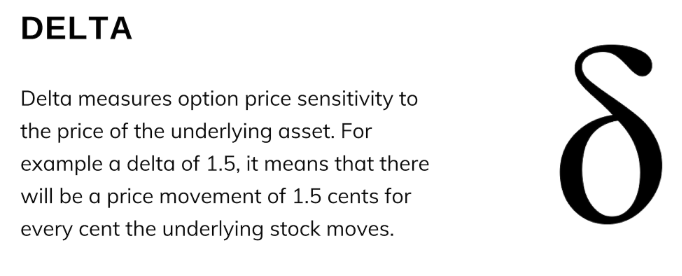
What Is Delta?
Delta measures option price sensitivity to changes in the price of the underlying asset.
Option Delta is perhaps one of the most vital measurement methods of all, as it can investigate the level of sensitivity that an option’s price will move, if there is a change in the underlying stock price.
(As with all the other options Greeks, we assume that all other of the options parameters don’t change when looking at delta).
If the option has a delta of 1.5, it means that there will be a price movement of 1.5 cents for every cent the underlying stock moves.
Therefore, this shows that an option with a high delta reading will increase or decrease in value more considering the direction of the price change.
As compared to another option with a low delta which will not move as much from changes in the price of the underlying stock.
Delta signs for long and short options:

How is Delta Used?
The importance of the information that the Greek Delta can provide is indispensable. This is especially the case where, in the real world, investors rarely hold options until maturity.
Knowing how much profit that can be reaped or the potential losses that will be incurred from a single movement in price will be one factor an investor uses to determine whether they should still hold the option or sell it.
Complication
Unfortunately there is a complication with delta: it also moves as the price moves. So that 1.5 delta option may move 1.5 cents higher for 1 cent move in the underlying, but then the delta may have changed to 1.6.
Hence any further increase in share price will cause an even bigger increase in the price of an option. This effect is an example of positive gamma – to be explained in our next lesson – and can be thought of as the price ‘accelerating’ higher.
Click here for more on the greek: options delta.
(NB We have recently published a post on the related concept of Position Delta).
Options Greeks: Gamma
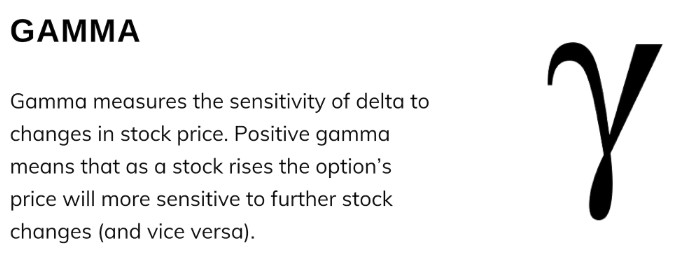
What is Gamma?
We saw above that the Greeks are an important measure of risk to used by options traders to assess the impact in changes of certain variables on the price of an option.
In particular we looked at one of these, delta: the sensitivity of option prices to changes in the price of the underlying security.
Unfortunately, again as we saw, the relationship between stock price sensitivity (delta) and the stock price is not linear.
For example if a stock moves up, call options will become even more sensitive to further changes to the stock price. This effect is called gamma. It measures the change in delta, i.e. sensitivity to stock price movements.
Positive gamma means that as a stock rises the option’s price will more sensitive to further stock changes. Negative gamma means the opposite: stock price rises cause stocks to be less sensitive.
Why should we be concerned about Gamma?
Gamma is the key enemy of many of the options strategies we use. It tends to rise as an option moves closer to expiration. Hence in the last week of an option’s life small changes in stock prices cause large, and accelerating, swings on options prices.
This is unfortunate as many of our favorite strategies – such as the iron condor or calendar spread – rely on time decay. They relay on time passing to make money.
Often a trader has to weigh up the potential profits, from time decay, of leaving a strategy on versus the increasing risk of the stock moving and wiping out those profits.
It is for this reason that most experienced options traders rarely keep a trade on until expiration. We take a particularly risk averse line: we tend to remove our standard time decay exploiting trades at least 2 weeks before expiration.
For example, look at our trade rules for putting on this calendar spread. Notice the last ‘Trade Management – Exit’ rule. We would get out of the trade within 2 weeks of expiration to avoid the gamma risk.
Such is the power of gamma that trading with positions with large gamma – expiration week trades for example – is known colloquially as ‘riding the gamma bull’. Not for the faint hearted.
Uses of Gamma
We’ve seen that Gamma is often seen as an enemy. But this is usually only relevant to those trades, admittedly the most popular, that relay on time decay to profit.
Some trades, however, take the opposite course: they take advantage of the accelerating price sensitivity from gamma to make money from expected changes in stock prices.
One good example of this is the simultaneous purchase of an at-the-money put and call, called a long straddle, Let’s say a stock was $650.
We expect significant stock movement, from a product launch for example, over the short term and so buy a $650 call and a $650 put.
Such a purchase has strong gamma. Stock movement not only increases the price of the spread, these price changes are increased the more the stock changes, either way.
(Don’t worry too much about the mechanics of this: we will have a more detailed course on straddles later).
The catch, and key risk, is time, the opposite of the trades mentioned above.
Time decay works against us here: if there is no stock movement then the spread will gradually lose money. Indeed the spread loses value every day – all things being equal – and so there is an amount of stock movement required each day just to break even.
The trader has to be sure that the stock move, and move quickly, for the trade to be profitable.
(This example is taken from a real life trade here. We used an APPL straddle to exploit expected movement from the iphone5 launch. Ignore, for now the discussion on increases in implied volatility: this will be part of the Vega lesson).
Gamma vs. time:
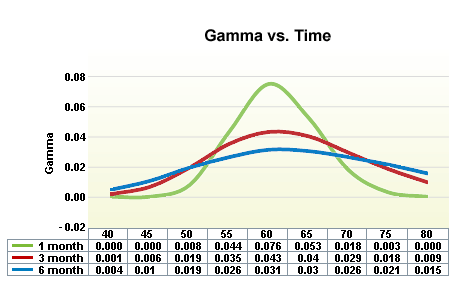
Gamma scalping
One advanced use of gamma is ‘gamma scalping’, something you may hear about from experienced traders.
It’s pretty complex – it takes advantage of the ‘boost’ in option price changes from excessive stock movement whilst managing delta risk (I said it was complex) – and I may include it in a later advanced post, but I suggest that most of you don’t worry about this strategy at present.
Click here for more on the Greek: options gamma.
Options Greeks: Vega
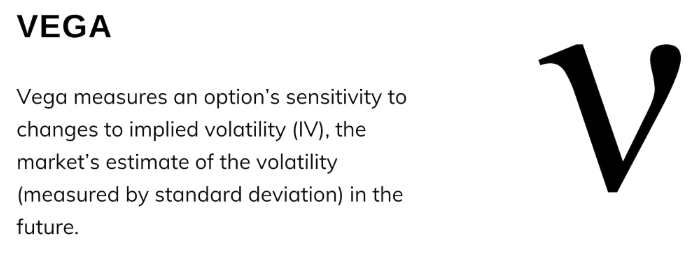
What Is Vega?
Vega is a measure of an option’s sensitivity to changes to implied volatility (IV). As we’ve seen earlier, implied volatility is the market’s estimate of the volatility (measured by standard deviation) in the future.
It’s an input into the standard options pricing models and hence any change in this expectation, in other words any change in implied volatility, will affect the price of options.
How does it affect the price?
In general bought options, either calls or puts, increase in value as IV increases. This makes sense: an option seller would want to be compensated more for the increased future risk, as priced by the market, of the option moving in the money.
Stocks expected to be more volatile, and hence have higher IVs, have higher options prices, everything else being equal.
Short options decrease in value, the higher IV is for the same (but opposite) reasons. Things get interesting once options are combined in a spread. Some combinations such as a Calendar Spread increase in value as IV increases. Others, such as the Iron Condor, decrease.
Uses of Vega
Many options strategies rely on picking the way volatility moves. For example should be believe that we are to have a market correction we would, of course, be interested in the effect of stock price falls on our options positions.
But we’d be also interested in what the associated increase in IV would have on the position. There are some trades that rely solely on Vega: volatility trades.
IV tends to be mean reverting and so any short term deviation could produce a correcting change in the near future.
For example many traders look for the difference between historical volatility – how volatile the market is right now – to implied volatility – a future volatility prediction.
There is some evidence to say if these two indicators diverge than they will soon get closer together. This can be traded if you know the volatility effect of IV on an options trade. In other words, Vega.
Click here for more on the Greek: options vega.
Options Greeks: Theta
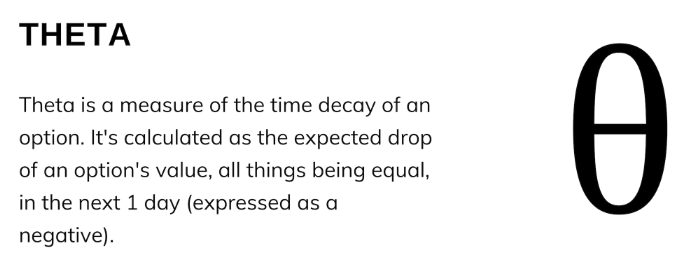
What Is Theta?
Theta is a measure of the time decay of an options, or option spread. As we have seen elsewhere in the courses, options are a decaying asset: they reduce in value over time.
All things being equal an option is worth more the longer it has to go until expiry; an option with 60 days of time left to expiry will be worth more than one with only 30 days.
The expected drop of an option value, again all things being equal, in the next 1 day is Theta (expressed as a negative).
For example, at the time of writing, you can buy an ATM June 13 445 APPL call with 23 days until expiration for about $12. It has a Theta of -0.24, meaning it will lose $0.24 in the next 24 hours if nothing – share price, volatility etc – changes.
Uses of Theta
Theta is the basis of many of the standard options trades we use in this course. Strategies which involve selling options – or at least there are ‘more’ sales than purchases – have positive theta (ie they rise in value over time).
If we were to sell the above AAPL call options for $12 and nothing changed, we could buy them back at $11.76, the next day for $0.24 profit. If nothing else changed of course.
This rather simplistic example shows the way to more (and much less risky) ways we can profit from theta. Take the vertical spread. Let’s say you thought Apple wasn’t going to rise in the next 23 days.
You could sell a 450 call and buy a 480 call and receive a net credit of $4.70. The 450 call has a theta of -0.24; the 480 call a theta of -0.14 and hence the net theta is -0.10. We have reduced our risk (of a significant share price increase) but are still making $0.10 a day all things being equal.
Effect of time on Theta
Theta is the effect of time on options pricing. However it too changes with time. In general theta increases as expiration nears. Another way of saying this is that the time decay accelerates closer to acceleration.
You can see this from our sold AAPL 445 call above. It will lose $0.24 between day 23 and day 22. If theta was constant it would only lose 23x$0.24=$5.52 of its value between now and expiration. But it is worth $12 – which must all be lost by day 23.
Hence Theta must increase at some stage this to happen. Here’s a graph of what happens:

Notice how the value of the option (time value) accelerates near the end of its life. This is the theta increasing.
Gamma and Theta
So why don’t you wait until the last few days to sell your options? All that nice accelerating time decay should reduce your option price quick only for to buy them back or let them expire for a quick profit. Easy.
Well, unfortunately not. We have been looking at Theta in isolation. But we know from our last course that another of the Greeks increases with time: gamma. This is the acceleration of the effect stock price has on the option price.
Increasing time decay is matched with increasing sensitivity for price changes and so any time decay could be wiped out by an adverse move in the share price.
This is a good example of the interplay between the Greeks. In general strategies that exploit theta have to contend with gamma and vice versa. We will see more interrelationships later. In the meantime though we will look at the last of the major Greeks, Rho.
Click here for more on the greek: options theta.
Options Greeks: Rho
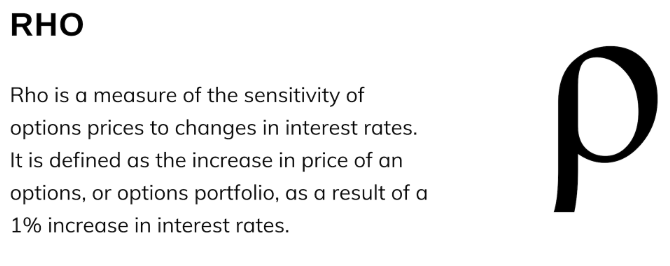
What Is Rho?
Rho is a measure of the sensitivity of options prices to changes in interest rates. It is defined as the increase in price of an options, or options portfolio, as a result of a 1% increase in interest rates.
Relevance
Rho is often ignored by options traders as interest rates are unlikely to change (much) during the course of most options spreads. Hence changes in interest rates are usually ignored.
However there are times where more notice should be taken of Rho. Long term options, such as LEAPS, are more sensitive to changes in interest rates, ie have a higher Rho.
At the time of writing an at the money AAPL call option with 32 days to go has a Rho of 0.3 (a 1% interest rate rise would produce a small, 0.3%, increase in the options price). However a LEAP with 578 days to go has a Rho of 2.2. Hence any LEAP strategy, such as our LEAP Covered Calls, would be affected somewhat by a change in interest rates.
The other time Rho should be at least considered is, of course, when interest rates are changing. At the time of writing, for example, there is a strong possibility that the Fed will remove its QE program thus causing, amongst other things, an increase in interest rates.
Hence, all things being equal, may be see an increase in options prices over the next few months/years.
In conclusion Rho can be an important factor in certain circumstances – when interest rates are expected to change and/or we are looking at long term options – but in general Rho is a far less important Greek than Delta, Gamma, Theta and Vega.
Click here for more on the Greek: options rho.
About the Author: Chris Young has a mathematics degree and 18 years finance experience. Chris is British by background but has worked in the US and lately in Australia. His interest in options was first aroused by the ‘Trading Options’ section of the Financial Times (of London). He decided to bring this knowledge to a wider audience and founded epsilonoptions.com in 2012.
Subscribe to SteadyOptions now and experience the full power of options trading at your fingertips. Click the button below to get started!
Join SteadyOptions Now!
Related articles:



There are no comments to display.
Join the conversation
You can post now and register later. If you have an account, sign in now to post with your account.
Note: Your post will require moderator approval before it will be visible.